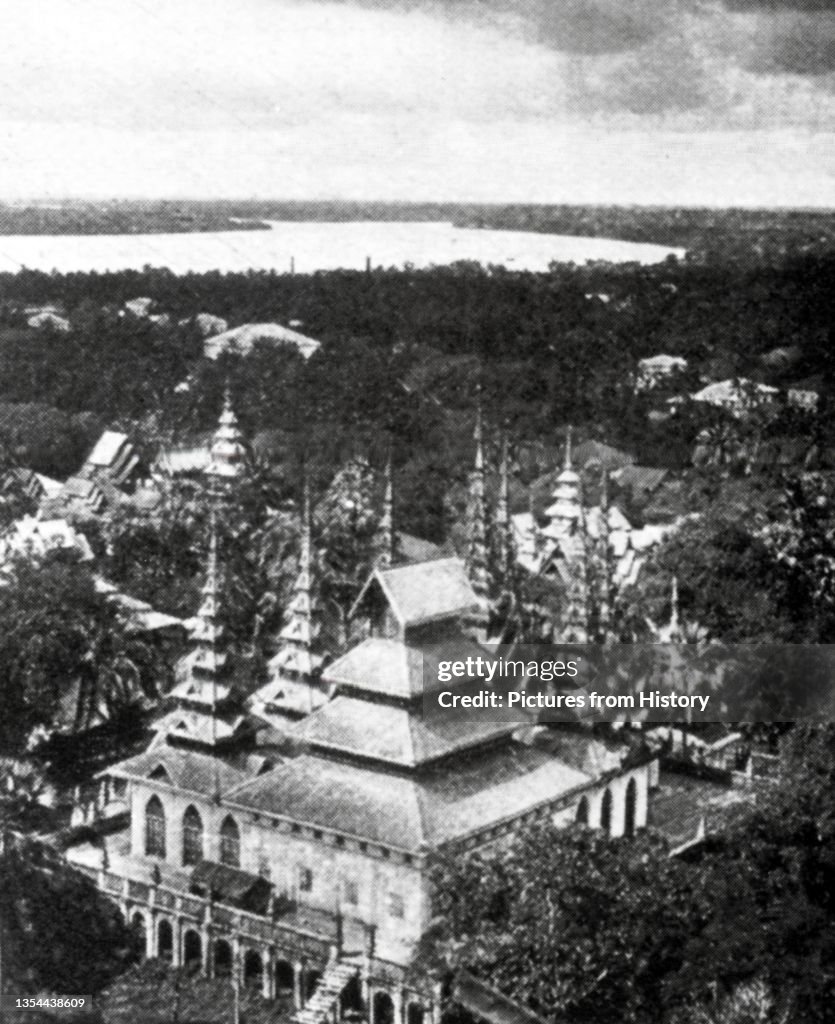Burma: A large Buddhist shelter (Burmese: 'kyaung') or resting place for monks, c.1892-96.
Legend attributes the first Buddhist doctrine in Burma to 228 BC when Sonna and Uttara, two ambassadors of the Emperor Ashoka the Great of India, came to the country with sacred texts. However, the golden era of Buddhism truly began in the 11th century after King Anawrahta of Pagan (Bagan) was converted to Theravada Buddhism. Today, 89% of the population of Burma is Theravada Buddhist. The British conquest of Burma began in 1824 in response to a Burmese attempt to invade India. By 1886, and after two further wars, Britain had incorporated the entire country into the British Raj. To stimulate trade and facilitate changes, the British brought in Indians and Chinese, who quickly displaced the Burmese in urban areas. To this day Rangoon and Mandalay have large ethnic Indian populations. Railways and schools were built, as well as a large number of prisons, including the infamous Insein Prison, then as now used for political prisoners. Burmese resentment was strong and was vented in violent riots that paralysed Rangoon on occasion all the way until the 1930s. Burma was administered as a province of British India until 1937 when it became a separate, self-governing colony. Burma finally gained independence from Britain on January 4, 1948. (Photo by: Pictures From History/Universal Images Group via Getty Images)

PURCHASE A LICENCE
How can I use this image?
£275.00
GBP
Getty ImagesBurma: A large Buddhist shelter (Burmese: 'kyaung') or resting place..., News Photo Burma: A large Buddhist shelter (Burmese: 'kyaung') or resting place... Get premium, high resolution news photos at Getty ImagesProduct #:1354438609
Burma: A large Buddhist shelter (Burmese: 'kyaung') or resting place... Get premium, high resolution news photos at Getty ImagesProduct #:1354438609
 Burma: A large Buddhist shelter (Burmese: 'kyaung') or resting place... Get premium, high resolution news photos at Getty ImagesProduct #:1354438609
Burma: A large Buddhist shelter (Burmese: 'kyaung') or resting place... Get premium, high resolution news photos at Getty ImagesProduct #:1354438609£375£150
Getty Images
In stockPlease note: images depicting historical events may contain themes, or have descriptions, that do not reflect current understanding. They are provided in a historical context. Learn more.
DETAILS
Restrictions:
Contact your local office for all commercial or promotional uses.
Credit:
Editorial #:
1354438609
Collection:
Universal Images Group
Date created:
02 January, 1892
Upload date:
Licence type:
Release info:
Not released. More information
Source:
Universal Images Group Editorial
Object name:
1060_05_cpa0010834
Max file size:
3777 x 4633 px (31.98 x 39.23 cm) - 300 dpi - 5 MB